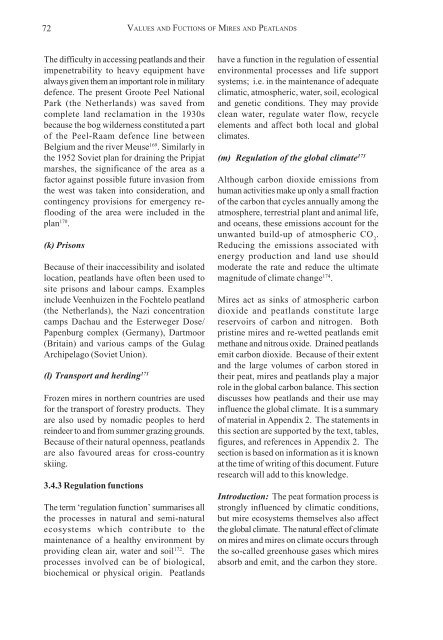wise use of mires and peatlands - Peatland Ecology Research Group
wise use of mires and peatlands - Peatland Ecology Research Group
wise use of mires and peatlands - Peatland Ecology Research Group
Create successful ePaper yourself
Turn your PDF publications into a flip-book with our unique Google optimized e-Paper software.
72 VALUES AND FUCTIONS OF MIRES AND PEATLANDSThe difficulty in accessing peatl<strong>and</strong>s <strong>and</strong> theirimpenetrability to heavy equipment havealways given them an important role in militarydefence. The present Groote Peel NationalPark (the Netherl<strong>and</strong>s) was saved fromcomplete l<strong>and</strong> reclamation in the 1930sbeca<strong>use</strong> the bog wilderness constituted a part<strong>of</strong> the Peel-Raam defence line betweenBelgium <strong>and</strong> the river Me<strong>use</strong> 169 . Similarly inthe 1952 Soviet plan for draining the Pripjatmarshes, the significance <strong>of</strong> the area as afactor against possible future invasion fromthe west was taken into consideration, <strong>and</strong>contingency provisions for emergency reflooding<strong>of</strong> the area were included in theplan 170 .(k) PrisonsBeca<strong>use</strong> <strong>of</strong> their inaccessibility <strong>and</strong> isolatedlocation, peatl<strong>and</strong>s have <strong>of</strong>ten been <strong>use</strong>d tosite prisons <strong>and</strong> labour camps. Examplesinclude Veenhuizen in the Fochtelo peatl<strong>and</strong>(the Netherl<strong>and</strong>s), the Nazi concentrationcamps Dachau <strong>and</strong> the Esterweger Dose/Papenburg complex (Germany), Dartmoor(Britain) <strong>and</strong> various camps <strong>of</strong> the GulagArchipelago (Soviet Union).(l) Transport <strong>and</strong> herding 171Frozen <strong>mires</strong> in northern countries are <strong>use</strong>dfor the transport <strong>of</strong> forestry products. Theyare also <strong>use</strong>d by nomadic peoples to herdreindeer to <strong>and</strong> from summer grazing grounds.Beca<strong>use</strong> <strong>of</strong> their natural openness, peatl<strong>and</strong>sare also favoured areas for cross-countryskiing.3.4.3 Regulation functionsThe term ‘regulation function’ summarises allthe processes in natural <strong>and</strong> semi-naturalecosystems which contribute to themaintenance <strong>of</strong> a healthy environment byproviding clean air, water <strong>and</strong> soil 172 . Theprocesses involved can be <strong>of</strong> biological,biochemical or physical origin. Peatl<strong>and</strong>shave a function in the regulation <strong>of</strong> essentialenvironmental processes <strong>and</strong> life supportsystems; i.e. in the maintenance <strong>of</strong> adequateclimatic, atmospheric, water, soil, ecological<strong>and</strong> genetic conditions. They may provideclean water, regulate water flow, recycleelements <strong>and</strong> affect both local <strong>and</strong> globalclimates.(m) Regulation <strong>of</strong> the global climate 173Although carbon dioxide emissions fromhuman activities make up only a small fraction<strong>of</strong> the carbon that cycles annually among theatmosphere, terrestrial plant <strong>and</strong> animal life,<strong>and</strong> oceans, these emissions account for theunwanted build-up <strong>of</strong> atmospheric CO 2.Reducing the emissions associated withenergy production <strong>and</strong> l<strong>and</strong> <strong>use</strong> shouldmoderate the rate <strong>and</strong> reduce the ultimatemagnitude <strong>of</strong> climate change 174 .Mires act as sinks <strong>of</strong> atmospheric carbondioxide <strong>and</strong> peatl<strong>and</strong>s constitute largereservoirs <strong>of</strong> carbon <strong>and</strong> nitrogen. Bothpristine <strong>mires</strong> <strong>and</strong> re-wetted peatl<strong>and</strong>s emitmethane <strong>and</strong> nitrous oxide. Drained peatl<strong>and</strong>semit carbon dioxide. Beca<strong>use</strong> <strong>of</strong> their extent<strong>and</strong> the large volumes <strong>of</strong> carbon stored intheir peat, <strong>mires</strong> <strong>and</strong> peatl<strong>and</strong>s play a majorrole in the global carbon balance. This sectiondiscusses how peatl<strong>and</strong>s <strong>and</strong> their <strong>use</strong> mayinfluence the global climate. It is a summary<strong>of</strong> material in Appendix 2. The statements inthis section are supported by the text, tables,figures, <strong>and</strong> references in Appendix 2. Thesection is based on information as it is knownat the time <strong>of</strong> writing <strong>of</strong> this document. Futureresearch will add to this knowledge.Introduction: The peat formation process isstrongly influenced by climatic conditions,but mire ecosystems themselves also affectthe global climate. The natural effect <strong>of</strong> climateon <strong>mires</strong> <strong>and</strong> <strong>mires</strong> on climate occurs throughthe so-called greenho<strong>use</strong> gases which <strong>mires</strong>absorb <strong>and</strong> emit, <strong>and</strong> the carbon they store.
















